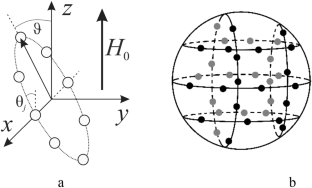环状自旋簇自由感应衰变的自旋波模型
IF 1.1
4区 物理与天体物理
Q4 PHYSICS, ATOMIC, MOLECULAR & CHEMICAL
引用次数: 0
摘要
研究采用类似于自旋波的集体模式的形式主义,对环状自旋团簇集合中的自由感应衰减(FID)进行了分析。研究得出了自旋波的弥散关系。对来自自旋簇的自由感应衰减进行了估算,并对系统参数进行了平均,以模拟球形结构或随机取向的环状集合发出的信号。在初始时间间隔内,根据高斯定律存在快速弛豫。在 T2 之后,信号以幂函数形式衰减,这与对环簇信号的直接数值模拟相吻合。本文章由计算机程序翻译,如有差异,请以英文原文为准。


Spin-Wave Model of Free Induction Decay in Ring Spin Cluster
The study presents an analysis of free induction decay (FID) in the ensemble of ring spin clusters using the formalism of collective modes similar to the spin waves. A dispersion relation for the waves is obtained. FID from a spin cluster is estimated and averaged over system parameters to simulate the signal given by a spherical structure or by an ensemble of rings withrandom orientation. There exists a fast relaxation according to the Gaussian law in the initial time interval. After T2, the signal decays as a power function which matches the direct numerical simulations of the signal from the ring clusters.
求助全文
通过发布文献求助,成功后即可免费获取论文全文。
去求助
来源期刊

Applied Magnetic Resonance
物理-光谱学
CiteScore
1.90
自引率
10.00%
发文量
59
审稿时长
2.3 months
期刊介绍:
Applied Magnetic Resonance provides an international forum for the application of magnetic resonance in physics, chemistry, biology, medicine, geochemistry, ecology, engineering, and related fields.
The contents include articles with a strong emphasis on new applications, and on new experimental methods. Additional features include book reviews and Letters to the Editor.
 求助内容:
求助内容: 应助结果提醒方式:
应助结果提醒方式:


